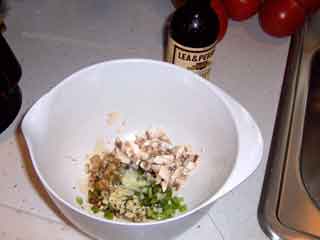Like most things, you can make this as complex as you'd like. The original concept, and this recipe, are based on the keep it simple philosophy.
here's what you'll need . . .
ground sirloin - at least 1/3rd to 1/2 lb. (serves two, 1 small loaf pan)
1 egg
1 slice interesting bread (we use our favorite Oat Nut bread)
milk to soak bread
diced red bell pepper
diced green bell pepper
sliced black olives
sliced mushrooms
minced sliced onion
1 clove garlic, minced
Worcestershire sauce
freshly ground black pepper
SriRacha or cayenne or Tabasco or. . . (optional)
Here's how you do it.
About an hour or so before you're going to make your meatloaf, get the egg out of the refrigerator and let it warm up to room temperature. If you want your eggs to combine well with other ingredients in almost any recipe, the egg cannot be cold, right out of the refrigerator. So always try to remember (or plan far enough in advance) to allow your egg(s) to warm up.
And if your ground beef is frozen, well, you're going to need to thaw it out before you'll be able to shape it into a loaf. Use the microwave, if you've got one; or just put the meat on a plate in the refrigerator for a few hours before you start. (The safest way to slow-thaw meats is in the refrigerator. The cold helps keep down the growth of bacteria .)
When you're ready to get started, preheat the oven to about 450° F. Put the bread slice in a shallow bowl and cover it with milk. Spread a drip or five of olive oil around the inside of a small loaf pan (8x3x3").

For a little loaf like this one, you'll only need a little bit of onion and peppers and such. We use a couple of thin slices of a small onion, which amounts to about ½ Tsp. or less when minced up. Similar amounts of diced green and/or red peppers are plenty. Though once proved wrong, our general approach is that there is no such thing as too much garlic, so a full clove tastes fine in our house. If you're garlic shy, try to find a smallish clove, or go ahead and waste a little excess if you must. And two mushrooms are probably enough for this sized loaf. Slice them thickly (3-4 slices per 'shroom) if you'd like noticeable nuggets of mushroom in your loaf; slice thinly, or even chop them up, if you just want the flavor. Add olives as you wish.
Toss all these chopped and diced and minced ingredients into the bottom of a mixing bowl. Add the meat. Give it a quick slug of Worcestershire sauce (¼ to ½ Tsp., depending on your tastes). I usually squeeze a little SriRacha in just for some extra zing, but it's certainly not necessary.
Add 6-8 grinds of black pepper, and, if you must, a pinch of salt. (Since salt tends to draw the juices out of foods, we try to reserve salt for the table; but sometimes a tiny bit during the cooking can 'improve' the flavor of the cooked food. In this case, the other flavors in the loaf are strong enough that we don't find any 'improvement' with the use of salt. But try it both ways for yourself, and go with whatever tastes best to you!)
Next, gently squeeze all the milk out of the bread slice (reserve the milk - you can use it in the gravy you'll make later!), and then crumble the bread lump onto the meat. Crack the egg on top of the pile. And have fun!

The only way to get the 'proper' texture to your final meatloaf is to get into that bowl with both hands. Squeeze, and roll, and squish, and turn and churn and otherwise mix everything up. You don't want to homogenize the mixture, so a minute or two will be plenty; but you do want to thoroughly combine everything, distributing all the ingredients throughout the loaf. When you're done, roll it all up into a ball (it will probably end up about the size of a fat baseball), and toss it into the loaf pan. Pat, push, press, and pamper the ball into a nice loaf shape, leaving at least a little room between the loaf and the sides of the pan. (If you want to be totally decadent, hide a few small chunks of cheddar cheese in the middle of your loaf!)

Put the pan in the preheated oven for about 5 - 6 minutes. Then turn the temperature down to about 325 - 350° F (don't forget or you'll just create a charcoal briquette!) and cook for 35-45 minutes. If you're paranoid, use a meat thermometer to check the internal temperature before you call the loaf done.
When the loaf is done, remove it from the pan and make some gravy. If you used ground sirloin, there won't be much fat in the pan, but you can always add a pat of butter or a Tbsp. of olive oil to give you enough fat to make a roux. And be sure to remember to use the milk you reserved earlier (along with vegetable and potato cooking water) as part of the liquid for your gravy. (And if gravy making is terra incognito for you, check out the instructions in the Maryland Fried Chicken recipe of Feb. 2005.)
Then slice it up and enjoy!














